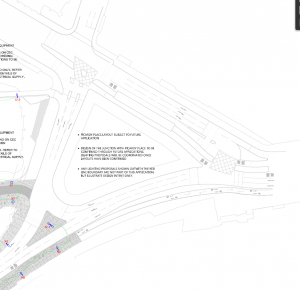Briefing paper by Living Streets Edinburgh and Spokes
1. Introduction
This briefing has been prepared jointly by Living Streets Edinburgh Group and Spokes, in the context of Councillor Booth’s motion to the 10th August 2017 Transport and Environment Committee, in particular the point that ‘the redesign of a significant city centre junction and surrounding streets presents an opportunity for traffic reduction, development of active travel infrastructure, and improvement of the public realm’
Both our organisations welcome the design’s planned significant improvement over the present highly sub-standard conditions for both cycling and walking in the area, but we also have major concerns over the design and the consultation process which we would ask you to address.
2. Policy context
Key relevant policy documents include the Scottish Government’s ‘Designing Streets’ (2010) which sets out the need for street design to change the emphasis ‘ towards place-making and away from a system focused upon the dominance of motor vehicles.’
The Council’s ‘Edinburgh Street Design Guidance’ (2015) includes commitments to ‘follow a design process that starts by considering the street as a place for people and recognising that streets have an important non-transport role’ and that the Council ‘will always prioritise improving conditions for pedestrians, especially for those with mobility impairments or other disabilities, for cyclists and for public transport users.’
The outcomes set out in the Council’s ‘Local Transport Strategy 2014-2019’ include a transport system ‘with an emphasis on encouraging walking, cycling and public transport use and a high quality public realm’, which is ‘part of a well planned, physically accessible, sustainable city that reduces dependency on car travel, with a public transport system, walking and cycling conditions to be proud of’, and in which ‘everyone should be able to get around the city regardless of income or disability.’ Elsewhere (section 4.5) the document notes that: ‘Although this strategy is about moving around, it is also about reducing the need for motorised travel, especially car travel. Less car traffic helps make a city a safer and more pleasant place to live, as well as an attractive place to invest.’
It should be noted that these policies are succeeding, as evidenced by the 2011 Census, Spokes traffic counts and other data. Edinburgh now has higher proportions of people who walk, cycle and take the bus to work than anywhere else in Scotland, and a declining proportion of people who drive to work. New developments should help maintain these admirable trends and achievements, and certainly not put them at risk.
3. The process – Leith Street & Picardy Place junction re-design
Living Streets Edinburgh, Spokes and other interested organisations have been pleased with the good level of consultation on other adjacent projects such as the West-East cycle route.
By contrast, in the case of Picardy Place – which will be a major change to the public realm – the level of consultation to date has been most unsatisfactory. There appears to have been no public consultation since a pre-application consultation in 2013 and ‘ground rules’ seem to have been set dating back to the tram proposals from 2009.
Both our organisations have only recently (12th July) had our first sight of the current plans. Moreover they have still not been sent to us or made public and, as far as we understand, there is no intention to hold a wider public consultation.
4. Specific design issues
- We welcome the planned reduction of vehicular space, but we believe there is still too much emphasis on providing for vehicles. 3-lane provision at the main gyratory intersection looks to be ‘accommodating’ rather than ‘restraining’ traffic in line with policy objectives, and is not conducive to safe cycling. Also, given that Leith Street will have been reduced to 2 lanes for a year, and closed for nearly another year, we question the need for the carriageway to be 4 lanes wide – some of this width would be better allocated to cyclists and pedestrians (see below), including the section of Leith Street where no cycle path is provided.
- While the provision of a dedicated cycle path and wider pavements is welcome, the cycle path and some pavements will narrower than they should be for these busy streets – in the case of the cycle lane just 2m wide, and in some pavement sections, less than the ‘desirable minimum’ of 4m or wider as set out in the Street Design Guidance.
- We consider it to be most unwise to incorporate shared cyclist / pedestrian space particularly as many cyclists will be on ‘A to B’ journeys rather than mingling. This is a recipe for conflict, with the most vulnerable users (including pedestrians who are frail or have a disability) likely to come off worst.
- Important green space and public realm (including mature trees) would be lost in front of the cathedral and on Picardy Place itself, in order to accommodate 3 lanes of traffic and the large island in the centre of the roundabout.
- In light of concerns about the gyratory intersection, the loss of public space and the relatively inaccessible central island (for which a hotel proposal has been withdrawn), we feel there is a great opportunity to explore removing the entire island and gyratory system from the design, thus creating improved conditions for cycling, and allowing the public realm and footway width to be increased on all three sides of the junction.
Conclusion
We urge the Council in its ongoing consultation and design processes to take on board these significant concerns, and to work towards a final design which is both a symbolic and very practical demonstration of the importance of (i) active travel and (ii) ‘place’ rather than ‘movement’, in a highly-visible and much-used area of the city centre. Furthermore, the design as it now stands should be made public and should be subject to a formal public consultation before it is finalised.
Living Streets Edinburgh Group / Spokes / 10 August 2017
